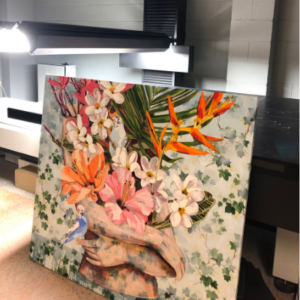Image credit: Jess Watts (artist)
How do I turn my drawing into a digital image? How do I convert my canvas painting to a digital file? I need digital art prints of my work, how do I do this?
These are all common questions and requests we get, and the process we use is exactly the same, regardless of the type of art.
When choosing to digitise your art professionally, there are two main options – artwork photography or artwork scanning. Both methods will deliver a high-resolution digital file of your artwork, but the quality and detail within this file (and subsequent prints you decide to make) will vary depending on whether you photographed or scanned your artwork.
This is a whole other topic in itself. We won’t delve into the detail here, but if you want to understand more, check out the article Should you photograph or scan your artwork?
To sum up, scanning is the superior method of digitising art, in almost every instance.
Photographing artwork often has limitations around image size, resolution, colour accuracy and lighting, even with professional services. And so, if you’re shopping around for an art digitisation service, it pays to make sure you understand their method and exactly what you’re going to get as a result.
How do we digitise art at Cie-Elle?
We are an artwork scanning service.
We also specialise in fine art printing but are renowned in Sydney and throughout Australia for our scanning technology, which captures an incredible amount of detail. It’s not uncommon for other fine art printing services to refer their clients to us to get the scanning component done.
The bee’s knees of artwork scanning technology
Not to beat our own drum, but our large format scanner is pretty mind-blowing. We use a German built Cruse scanner and it’s the most advanced scanning technology available in Australia. It’s actually the same technology used by the Vatican and leading museums and galleries around the globe.
We scan at the same size of the original (1-1 scale), so the entire artwork is in sharp focus which means you won’t be limited by resolution and can reproduce your art in sizes larger than the original. Technically speaking, artworks are captured at over 800 megapixels. Size is also no barrier, with a huge table size of 1400x2200mm.
In short, you’ll be pretty amazed at the level of depth achieved in your digital file and you’ll leave with the best digital capture of your artwork that you can possibly get.
I’m ready to scan my artwork, what’s the process?
To simplify the process, there are three steps involved:
1) Scan the artwork.
You can make an appointment and bring your artwork in or post it to us if travel to Sydney is not possible.
We do offer on the spot scans (you wait while we scan your artwork). But for larger jobs or multiple scans, it’s more convenient for you to leave the artwork with us and pick up later along with the scanned files when the job is done.
2) Apply colour adjustments to the scanned file.
After the artwork is scanned, we will apply colour adjustments to the scanned file. There are three options to choose from – basic, standard or full colour correction. What we recommend and what you choose will largely depend on why you need the scanned file. We’ll go into a little more detail on this below
3) Supply high res files on USB or upload link to download file.
Why do you need to digitise your art?
The reason you need a digital file of your work will affect the process slightly. The actual scanning process is the same but how we treat the scanned file will change depending on why you need it.
For example, say need a digital file of your work to submit to a gallery, for a website or to capture/preserve your work. For this you only really need basic colour adjustments made to the scanned file.
On the other hand, if you are scanning your art with the intention to produce high quality giclée prints to sell, then it’s worthwhile looking at standard or full colour correction options. This will ensure better colour accuracy between the original artwork and the print.
Artwork scanning and fine art printing
If you are looking to digitise your art (scans) and do prints with us, then it’s at this artwork scanning point that we start talking about sizing options and paper stock. There is also further colour matching and tweaking, test strip prints and so on, once you go down this path.
And so, it’s worthwhile thinking about what you might need or intend to do (e.g. just scans or scanning and fine art printing) even before you start the process. That way you get the most out of each step of the process.
Thinking about scanning your artwork and getting digital prints done? Learn more about our fine art reproduction process.
Want to see for yourself?
We’d love you to pop in and see some examples of the work we’ve done.
Book an appointment now or call us on 02 9638 1533 for a no obligation chat.


